Abadan, Iran
Abadan (Persian: آبادان Ābādān, pronounced [ʔɒːbɒːˈdɒːn]) is a city and capital of Abadan County, Khuzestan Province, which is located in the southwest of Iran. It lies on Abadan Island (68 km or 42 mi long, 3–19 km or 2–12 miles wide). The island is bounded in the west by the Arvand waterway and to the east by the Bahmanshir outlet of the Karun River (the Arvand Rood), 53 kilometres (33 mi) from the Persian Gulf,[3] near the Iran–Iraq border. Abadan is 140 km from the provincial capital city of Ahvaz.
Abadan آبادان | |
|---|---|
City | |
| Ābādān | |
 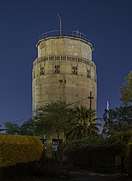 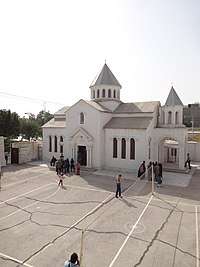 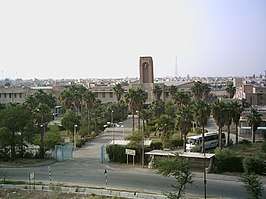 | |
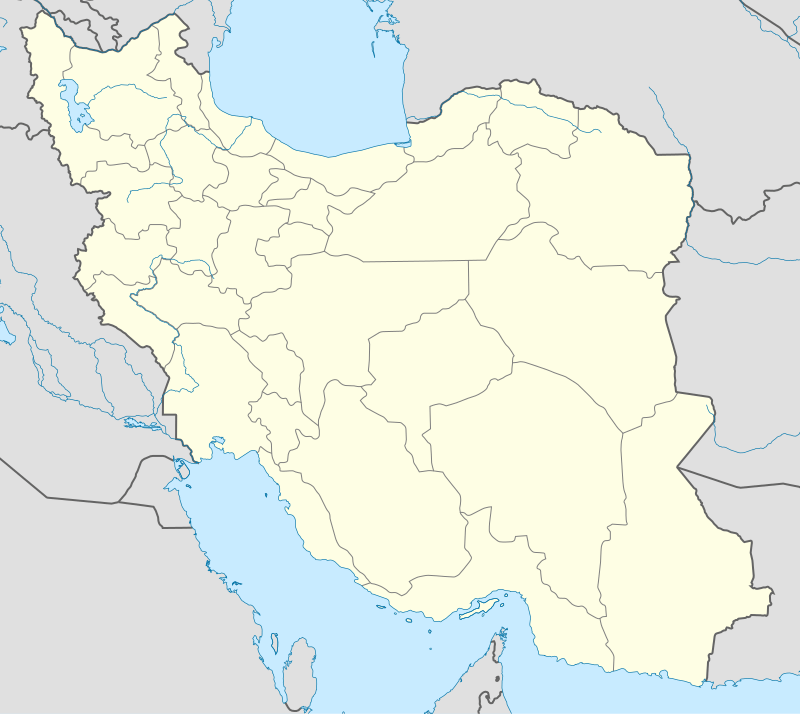 Abadan Location in Iran and Asia | |
| Coordinates: 30°20′21″N 48°18′15″E | |
| Country | |
| Province | Khuzestan |
| County | Abadan |
| District | Central |
| Government | |
| • Mayor | Mahmood Reza Shirazi [1] |
| Area | |
| • Urban | 1,275 km2 (492 sq mi) |
| Elevation | 3 m (10 ft) |
| Population (2016 Census) | |
| • Density | 167/km2 (430/sq mi) |
| • Urban | 231,476[2] |
| • Population Rank in Iran | 40th |
| Demonym(s) | Abadani (en) |
| Time zone | UTC+03:30 (IRST) |
| • Summer (DST) | UTC+04:30 (IRDT) |
| Area code(s) | (+98) 061 |
| Climate | BSk |
| Website | www.Abadan.ir |
Etymology
The earliest mention of the island of Abadan, if not the port itself, is found in works of the geographer Marcian, who renders the name "Apphadana".[4] Earlier, the classical geographer Ptolemy notes "Apphana" as an island off the mouth of the Tigris (which is, where the modern Island of Abadan is located). An etymology for this name is presented by B. Farahvashi to be derived from the Persian word "ab" (water) and the root "pā" (guard, watch) thus "coastguard station").[5]
In Islamic times, a pseudo-etymology was produced by the historian Ahmad ibn Yahya al-Baladhuri (d. 892) quoting a folk story that the town was presumably founded by one "Abbad bin Hosayn" from the Arabian Tribe of Banu Tamim, who established a garrison there during the governorship of Hajjaj in the Ummayad period.[5]
In the subsequent centuries, the Persian version of the name had begun to come into general use before it was adopted by official decree in 1935.[5]
Population
| Year | People |
|---|---|
| 1910 | 400 |
| 1949 | 173,000[6] |
| 1956 | 220,000[7] |
| 1980 | 300,000 |
| 1986 | 6 |
| 1991 | 84,774[8] |
| 2001 | 206,073 |
| 2006 | 217,988[9] |
The civilian population of the city dropped close to zero during the eight years of the Iran–Iraq War (1980–1988). The 1986 census recorded only 6 people. In 1991, 84,774 had returned to live in the city.[8] By 2001, the population had jumped to 206,073, and it was 217,988, in 48,061 families, according to 2006 census.[9] Abadan Refinery is one of the largest in the world. The population today has reached almost 350,000 people.
Only 9% of managers (of the oil company) were from Khuzestan. The proportion of natives of Tehran, the Caspian, Azerbaijan, and Kurdistan rose from 4% of blue collar workers to 22% of white collar workers to 45% of managers, thus Arabic-speakers were concentrated on the lower rungs of the work force, managers tended to be brought in from some distance.[10] There is also a single Armenian church in the centre of the city.
History
Abadan is thought to have been further developed into a major port city under the Abbasids' rule. The city was then a commercial source of salt and woven mats.[3] The siltation of the river delta forced the town further away from water; In the 14th century, however, Ibn Battutah described Abadan just as a small port in a flat salty plain.[7] Politically, Abadan was often the subject of dispute between the nearby states. In 1847, Persia acquired it from the Ottoman Empire[8] in which state Abadan has remained since. From the 17th century onward, the island of Abadan was part of the lands of the Arab Ka'ab (Bani Kaab) tribe. One section of the tribe, Mohaysen, had its headquarters at Mohammara (now Khorramshahr), until the removal of Shaikh Khaz'al Khan in 1924.[11]

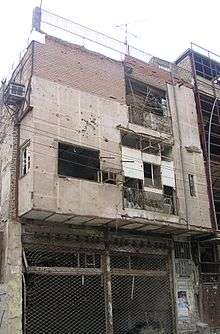
It was not until the 20th century that rich oil fields were discovered in the area. On 16 July 1909, after secret negotiation with the British consul, Percy Cox, assisted by Arnold Wilson, and Sheik Khaz'al agreed to a rental agreement for the island, including Abadan.[12][13][14][nb 1] The Sheik continued to administer the island until 1924.[15] The Anglo-Persian Oil Company built their first pipeline terminus oil refinery in Abadan, starting in 1909 and completing it in 1912, with oil flowing by August 1912 (see Abadan Refinery).[16][17] Refinery throughput numbers rose from 33,000 tons in 1912–1913 to 4,338,000 tons in 1931.[15] By 1938, it was the largest in the world.
During World War II, Abadan was the site of brief combat between Iranian forces and British and Indian troops during the Anglo-Soviet invasion of Iran. Later, Abadan was a major logistics centre for Lend-Lease aircraft being sent to the Soviet Union by the United States.[18][19]
In 1951, Iran nationalised all oil properties and refining ground to a stop on the island. Rioting broke out in Abadan, after the government had decided to nationalise the oil facilities, and three British workers were killed.[20] It was not until 1954 that a settlement was reached, which allowed a consortium of international oil companies to manage the production and refining on the island.[21] That continued until 1973, when the NIOC took over all facilities.[16] After the total nationalisation, Iran focused on supplying oil domestically and built a pipeline from Abadan to Tehran.[16]

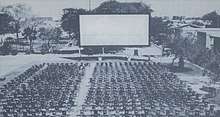
Abadan was not a major cultural or religious centre, but it played an important role in the Islamic Revolution. On 19 August 1978, the anniversary of the US-backed coup d'état that had overthrown the nationalist and popular Iranian prime minister, Mohammed Mossadegh, the Cinema Rex, a movie theatre in Abadan, was set ablaze. The Cinema Rex Fire caused 430 deaths,[22][nb 2] but more importantly, it was another event that kept the Islamic Revolution moving ahead. At the time, there was much confusion and misinformation about the perpetrators of the incident. The public largely put the blame on the local police chief and also the Shah and SAVAK.[23][24][25][26] The reformist Sobhe Emrooz newspaper in one of its editorials revealed that the Cinema Rex was burned down by radical Islamists. The newspaper was shut down immediately after. Over time, the true culprits, radical Islamists, were apprehended, and the logic behind this act was revealed, as they were trying both to foment the general public to distrust the government even more, and they also perceived cinema as a link to the Americans.[24][27] The fire was one of four during a short period in August, with other fires in Mashhad, Rizaiya, and Shiraz.[22] In September 1980, Abadan was almost overrun during a surprise attack on Khuzestan by Iraq, marking the beginning of the Iran–Iraq War. For 12 months, Abadan was besieged, but never captured, by Iraqi forces, and in September 1981, the Iranians broke the siege of Abadan.[28] Much of the city, including the oil refinery, which was the world's largest refinery with capacity of 628,000 barrels per day, was badly damaged or destroyed by the siege and by bombing.[29] Prior to the war, the city's civilian population was about 300,000, but at the war's end nearly the entire populace had sought refuge elsewhere in Iran.
After the war, the biggest concern was the rebuilding of Abadan's oil refinery, as it was operating at 10% of capacity due to damage.[30] In 1993, the refinery began limited operation and the port reopened. By 1997, the refinery reached the same rate of production as before the war. Recently, Abadan has been the site of major labour activity as workers at the oil refineries in the city have staged walkouts and strikes to protest non-payment of wages and the political situation in the country.[31]
First of Iran
- The first photography association in the Middle East[32]
- The first refinery in the Middle East[33]
- Iran first petrochemical plant[34][35][36]
- Iran first public relations[37]
- The first trolley in Iran
- The first traffic department in Iran
- The first radio and television station after Tehran[38]
- The first filling station in Iran[39]
- The first kindergarten in Iran
- The first technical and vocational school center in Iran[38]
- Iran first non-profit school
- Iran first official football team[40]
- The first motorcycle track, car ride, squash in Iran
- The first bicycle and motorcycle parking in Iran
- The first pizza shop in Iran[41]
Recent events
To honor the 100th anniversary of the refining of oil in Abadan, city officials are planning an oil museum.[42] The Abadan oil refinery was featured on the reverse side of Iran's 100-rial banknotes printed in 1965 and from 1971 to 1973. Abadan today has been declared as a free zone city. The healthy relationship between Iran and Iraq has become one of the transit cities connecting both countries through a 40-minute drive.
Geography
Climate
The climate in Abadan is arid (Köppen climate classification BWh) and similar to Baghdad's, but slightly hotter due to Abadan's lower latitude. Summers are dry and extremely hot, with temperatures above 45 °C (113 °F) almost daily and temperatures above 50 °C (122 °F) can be almost common. Abadan is notably one of the few hottest populated places on earth and experiences a few sand and dust storms per year. Winters are mildly wet and spring-like, though subject to cold spells. Winter temperatures are around 16–20 °C (61–68 °F). The world's highest unconfirmed temperature was a temperature flare up during a heat burst in June 1967, with a temperature of 87 °C (189 °F).[43] The lowest recorded temperature in the city range is −4 °C (25 °F). which was recorded on 20 January 1964 and 3 February 1967 while the highest is 53 °C (127 °F), recorded on 11 July 1951 and 9 August 1981.[44]
| Climate data for Abadan (1951–2010) | |||||||||||||
|---|---|---|---|---|---|---|---|---|---|---|---|---|---|
| Month | Jan | Feb | Mar | Apr | May | Jun | Jul | Aug | Sep | Oct | Nov | Dec | Year |
| Record high °C (°F) | 29.0 (84.2) |
34.0 (93.2) |
39.2 (102.6) |
42.8 (109.0) |
48.4 (119.1) |
53.0 (127.4) |
53.0 (127.4) |
53.0 (127.4) |
49.4 (120.9) |
43.2 (109.8) |
37.0 (98.6) |
29.8 (85.6) |
53.0 (127.4) |
| Average high °C (°F) | 18.1 (64.6) |
20.9 (69.6) |
25.9 (78.6) |
32.2 (90.0) |
39.2 (102.6) |
43.8 (110.8) |
45.4 (113.7) |
45.4 (113.7) |
42.5 (108.5) |
36.1 (97.0) |
26.8 (80.2) |
19.9 (67.8) |
33.0 (91.4) |
| Daily mean °C (°F) | 12.7 (54.9) |
15.0 (59.0) |
19.4 (66.9) |
25.2 (77.4) |
31.2 (88.2) |
35.2 (95.4) |
36.7 (98.1) |
36.3 (97.3) |
33.0 (91.4) |
27.5 (81.5) |
20.0 (68.0) |
14.3 (57.7) |
25.5 (77.9) |
| Average low °C (°F) | 7.3 (45.1) |
9.1 (48.4) |
13.0 (55.4) |
18.1 (64.6) |
23.3 (73.9) |
26.5 (79.7) |
28.0 (82.4) |
27.3 (81.1) |
23.4 (74.1) |
18.9 (66.0) |
13.2 (55.8) |
8.7 (47.7) |
18.1 (64.6) |
| Record low °C (°F) | −4.0 (24.8) |
−4.0 (24.8) |
−1.0 (30.2) |
7.0 (44.6) |
12.0 (53.6) |
17.0 (62.6) |
17.0 (62.6) |
19.4 (66.9) |
14.0 (57.2) |
7.0 (44.6) |
−1.6 (29.1) |
−1.0 (30.2) |
−4.0 (24.8) |
| Average precipitation mm (inches) | 35.5 (1.40) |
20.0 (0.79) |
19.2 (0.76) |
14.4 (0.57) |
3.2 (0.13) |
0.1 (0.00) |
0.0 (0.0) |
0.0 (0.0) |
0.1 (0.00) |
3.9 (0.15) |
20.5 (0.81) |
36.4 (1.43) |
153.3 (6.04) |
| Average rainy days | 4.7 | 3.4 | 3.3 | 2.2 | 0.9 | 0.0 | 0.0 | 0.0 | 0.0 | 0.6 | 2.6 | 4.6 | 22.3 |
| Average relative humidity (%) | 70 | 61 | 51 | 44 | 33 | 26 | 28 | 31 | 34 | 45 | 58 | 69 | 45 |
| Mean monthly sunshine hours | 180.6 | 195.0 | 222.3 | 221.6 | 262.9 | 292.1 | 305.1 | 290.4 | 290.4 | 263.4 | 202.4 | 182.5 | 2,908.7 |
| Source: Iran Meteorological Organization (records),[44] (temperatures),[45] (precipitation),[46] (humidity),[47] (days with precipitation),[48] (sunshine)[49] | |||||||||||||
Economics and Education
The Abadan Institute of Technology was established in Abadan in 1939.[15] The school specialized in engineering and petroleum chemistry, and was designed to train staff for the refinery in town. The school's name has since changed several times, but since 1989 has been considered a branch campus of the Petroleum University of Technology, centred in Tehran. Abadan University of Medical Sciences, It was founded by Ministry of Health and Medical Education in September 1941 as a Nursing Faculty and in 2012 it became an independent faculty of medical school. Program study of this school is similar to curriculum that applies most Iranian medical faculties.
Abadan was chosen for constructing a refinery because of its strategic position and proximity to other resources. The Abadan Refinery construction project started in 1909 and its operation began in 1962 by a production capacity of 2500 barrels per day.
There is an international airport in Abadan. It is represented by the IATA airport code ABD.[50] There is a large amount of external investment from East Asian countries that are building oil refineries and developing a lot of real estate.
Today, Abadan is known for its lively fish market where locals buy fresh catch of the day used in the many delicious seafood dishes of the city. Abadan is also part of the Arvand Free Zone, a 155 square kilometer industrial and security zone.[51]
Major corporations
|
|
University
- Petroleum University of Technology
- Abadan University of Medical Sciences
- Islamic Azad University of Abadan
- MehrArvand University
- PNU of Abadan
Main sights


Bridge
- Bahmanshir Bridge at Istgah-e Haft
- Imam Reza Cable Bridge
Mosques
Museums
- Abadan Museum
- Historical and Handwritten Documents Museum
- Abadan Gasoline House Museum
- Oil Museum of Abadan
Church
- St. Karapet Armenian Church
Cinema
- Cinema Naft
- Shirin Movie Theater
Notable people
- Nasser Taghvai - Director
- Amir Naderi - Director
- Ahmad Reza Abedzadeh - Football player
- Najaf Daryabandari - Writer
- Hamid Farrokhnezhad - Actor
- Bahman Golbarnezhad - Paralympic racing cyclist
- Abie Nathan - Peace activist
- Gholam Hossein Mazloumi - Football coach
- Firoozeh Dumas - Writer
- Zoya Pirzad - Writer
- Martik - Singer
- Dariush Farhang - Actor
- Parviz Dehdari - Football coach
- Cyma Zarghami - TV producer
- Patrik Baboumian - Strongman
- Bizhan Emkanian - Actor
- Hossein Vafaei - Snooker player
- Mehdi Hasheminasab - Football player
- Manouchehr Mohammadi - Film producer
- Nasrollah Radesh - Actor
- Sussan Babaie - Art
- Hossein Nassim - Water polo coach
- Mohsen Bayatinia - Football player
- Mojahed Khaziravi - Football player
- Hossein Kanaanizadegan - Football player
- Parviz Mazloumi - Football coach
- Farhad Hasanzadeh - Poet
- Hamid Rashidi - Lawyer
- Siroos Moghaddam - Director
- Nader Soleimani - Actor
- Linda Kiani - Actress
Transportation
By plane
The city is served by Abadan-Ayatollah Jami International Airport with flights on various commercial airlines.
By train
Nearest railway station is in Khorramshahr, about 10 km north of Abadan. Daytime trains from Ahvaz as well as overnight trains from Tehran and Mashhad are available.
Sport
Sanat Naft Abadan F.C., is one of the Iranian football clubs that is currently competing with other teams in the Iranian Football Premier League. Takhti Stadium, the main stadium is the city and the team.
Sister cities
See also
- Abadan Crisis
- Abadan crisis timeline
- Battle of Abadan
- Bechari House
- Bostan
- Iran–Iraq War
- Khorramshahr
- Shadegan
- Susangerd
- Tidal irrigation at Abadan island, Iran
Notes
Footnotes
- "Statistical Center of Iran > Home". amar.org.ir.
- Hoiberg 2010, p. 6
- Hoeschel et al. 1600, p. 48
- Elwell-Sutton & de Planhol 1982, p. 52
- Hein & Sedighi 2016.
- Hoiberg 2010, p. 7
- Lagassé 2000, p. 2
- Vadahti 2006.
- Elwell-Sutton & de Planhol 1982, pp. 55–56
- Elwell-Sutton & de Planhol 1982, p. 53
- Ferrier 1991, pp. 641–42
- Greaves 1991, pp. 418–19
- Abrahamian 2008, p. 56
- Ferrier 1991, pp. 647–48
- MacPherson 1989, p. 164
- Issawi 1991, pp. 606–07
- Ferrier 1991, p. 651
- "Document Detail for IRISNUM= 00190278". Air Force History Index. 3 April 1987. Retrieved 6 August 2014.
- Wilber 1984, p. 141
- Melamid 1997, p. 6
- Chelkowski 1991, p. 800
- Abrahamian 2008, p. 159
- Axworthy 2013, pp. 108–09
- Daniel 2001, pp. 167–68
- Satrapi 2003, pp. 14–15
- Keddie 2003, p. 231
- Daniel 2001, p. 208
- MacPherson 1989, p. 154
- Axworthy 2013, p. 309
- Mather 2009
- Iran's first in Abadan
- The first computer and refinery in the Middle East
- Abadan, the city of the first
- Cities of the Middle East and North Africa: A Historical Encyclopedia
- Architecture and Globalisation in the Persian Gulf Region
- When Iran’s Abadan was Capital of the World | Abadan, Civilization & Modernity
- Book of History of Television and Radio in Iran, Page 23
- 1927 / The first filling station in Iran
- 13 things you might not know about Iran - ESPN.com
- Cheat Sheet on Iranian Restaurants and Street Food
- "Southern Iran Craves for an Oil Museum". Petro Energy Information Network. 22 October 2005. Retrieved 6 August 2014.
- Burt 2004, p. 36
-
- "Highest record temperature in Abadan by Month 1951–2010". Iran Meteorological Organization. Archived from the original on 27 November 2015. Retrieved 8 April 2015.
- "Lowest record temperature in Abadan by Month 1951–2010". Iran Meteorological Organization. Archived from the original on 27 November 2015. Retrieved 8 April 2015.
-
- "Average Maximum temperature in Abadan by Month 1951–2010". Iran Meteorological Organization. Archived from the original on 27 November 2015. Retrieved 8 April 2015.
- "Average Mean Daily temperature in Abadan by Month 1951–2010". Iran Meteorological Organization. Archived from the original on 8 December 2015. Retrieved 8 April 2015.
- "Average Minimum temperature in Abadan by Month 1951–2010". Iran Meteorological Organization. Archived from the original on 27 November 2015. Retrieved 8 April 2015.
- "Monthly Total Precipitation in Abadan by Month 1951–2010". Iran Meteorological Organization. Archived from the original on 3 December 2015. Retrieved 8 April 2015.
- "Average relative humidity in Abadan by Month 1951–2010". Iran Meteorological Organization. Archived from the original on 26 November 2015. Retrieved 8 April 2015.
- "No. Of days with precipitation equal to or greater than 1 mm in Abadan by Month 1951–2010". Iran Meteorological Organization. Archived from the original on 27 November 2015. Retrieved 8 April 2015.
- "Monthly total sunshine hours in ABADAN by Month 1951–2010". Iran Meteorological Organization. Retrieved 8 April 2015.
- Flightradar24. "Flightradar24.com – Live flight tracker!". Flightradar24.
- Abadan city Book. 187.1.1
References
- Abrahamian, Ervand (2008). A History of Modern Iran. Cambridge, UK: Cambridge University Press. ISBN 978-0-521-52891-7.CS1 maint: ref=harv (link)
- Axworthy, Michael (2013). Revolutionary Iran: A History of the Islamic Republic. Oxford, UK: Oxford University Press. ISBN 978-0-19-932226-8.CS1 maint: ref=harv (link)
- Burt, Christopher C. (2004). Extreme Weather: A Guide & Record Book. New York, NY: W. W. Norton & Company. ISBN 978-0-393-32658-1.CS1 maint: ref=harv (link)
- Chelkowski, Peter (1991). "21: Popular Entertainment, Media and Social Change in Twentieth-century Iran". In Avery, Peter; Hambly, Gavin; Melville, Charles (eds.). The Cambridge History of Iran. 7: From Nadir Shah to the Islamic Republic. Cambridge, UK: Cambridge University Press. ISBN 978-0-521-20095-0.CS1 maint: ref=harv (link)
- Daniel, Elton L. (2001). The History of Iran. Westport, CT: Greenwood Press. ISBN 978-0-313-30731-7. ISSN 1096-2905. LCCN 00-033132.CS1 maint: ref=harv (link)
- Elwell-Sutton, L. P.; de Planhol, X. (1982). "Ābādān". In Yarshater, Ehsan (ed.). Encyclopædia Iranica. I: Āb-Abd-al-HamĪd. Routledge & Kegan Paul. pp. 51–57. ISBN 978-0710090904. Archived from the original on 16 May 2014. Retrieved 6 August 2014.CS1 maint: ref=harv (link)
- Ferrier, Ronald (1991). "18: The Iranian Oil Industry". In Avery, Peter; Hambly, Gavin; Melville, Charles (eds.). The Cambridge History of Iran. 7: From Nadir Shah to the Islamic Republic. Cambridge, UK: Cambridge University Press. ISBN 978-0-521-20095-0.CS1 maint: ref=harv (link)
- Greaves, Rose (1991). "11: Iranian Relations with Britain and British India, 1798–1921". In Avery, Peter; Hambly, Gavin; Melville, Charles (eds.). The Cambridge History of Iran. 7: From Nadir Shah to the Islamic Republic. Cambridge, UK: Cambridge University Press. ISBN 978-0-521-20095-0.CS1 maint: ref=harv (link)
- Hein, Carola; Sedighi, Mohamad (2016). "Iran's Global Petroleumscape: The Role of Oil in Shaping Khuzestan and Tehran". Architectural Theory Review. 21 (3): 349–374. doi:10.1080/13264826.2018.1379110.CS1 maint: ref=harv (link)
- Hoeschel, David; Heracleensis, Marcianus; von Karyanda, Skylax; Messenius, Dicaearchus; Characenus, Isidorus (1600). Geographica Marciani Heracleotae, Scylacis caryandensis, artemidoriephesii, dicaearchi messenii, isidori characeni. Augsburg.CS1 maint: ref=harv (link)
- Hoiberg, Dale H., ed. (2010). "Ābādān". Encyclopædia Britannica. 1: A-ak Bayes (15th ed.). Chicago, Illinois: Encyclopædia Britannica, Inc. pp. 6–7. ISBN 978-0-85229-961-6. LCCN 2002113989.CS1 maint: ref=harv (link)
- Issawi, Charles (1991). "16: European Economic Penetration, 1872–1921". In Avery, Peter; Hambly, Gavin; Melville, Charles (eds.). The Cambridge History of Iran. 7: From Nadir Shah to the Islamic Republic. Cambridge, UK: Cambridge University Press. ISBN 978-0-521-20095-0.CS1 maint: ref=harv (link)
- Keddie, Nikki R. (2003). Modern Iran: Roots and Results of Revolution (Revised ed.). New Haven, CT: Yale University Press. ISBN 978-0-300-09856-3.CS1 maint: ref=harv (link)
- Lagassé, Paul, ed. (2000). "Abadan". The Columbia Encyclopedia (6th ed.). New York, NY: Columbia University Press. ISBN 978-0-7876-5015-5. LCCN 00-027927.CS1 maint: ref=harv (link)
- MacPherson, Angus (1989). "3: The Economy". In Metz, Helen Chapin (ed.). Iran: A Country Study. Area Handbook Series (4th ed.). Washington, DC: Government Printing Office.CS1 maint: ref=harv (link)
- Mather, Yassamine (19 November 2009). "Workers organise against regime". Weekly Worker. Archived from the original on 18 March 2016. Retrieved 6 August 2014.CS1 maint: ref=harv (link)
- Melamid, Alexander (1997). "Abadan". In Johnston, Bernard (ed.). Collier's Encyclopedia. I: A to Ameland (1st ed.). New York, NY: P. F. Collier.CS1 maint: ref=harv (link)
- NOAA (2013). "Abadan Climate Normals 1961–1990". National Oceanic and Atmospheric Administration. Retrieved 6 August 2014.CS1 maint: ref=harv (link)
- Satrapi, Marjane (2003). Persepolis: The Story of a Childhood. New York, NY: Pantheon Books. ISBN 978-0-375-71457-3.CS1 maint: ref=harv (link)
- Vadahti, M. (2006). "سرشماري عمومي نفوس و مسكن 1385 (بدون احتساب خانوارهاي موسسه اي و غيرساكن)" [Census of Population and Housing 1385 (excluding institutional households and nomads)]. Archived from the original (Excel) on 11 November 2011.CS1 maint: ref=harv (link)
- Wilber, Donald N. (1984) [1948]. Iran: Past and Present: From Monarchy to Islamic Republic (9th ed.). Princeton, NJ: Princeton University Press. ISBN 978-0-691-00025-1.CS1 maint: ref=harv (link)
Further reading
- Axworthy, Michael (2008). A History of Iran: Empire of the Mind. New York: Basic Books. ISBN 978-0-465-00888-9.CS1 maint: ref=harv (link)
External links
| Wikimedia Commons has media related to Abadan. |
| Wikivoyage has a travel guide for Abadan. |
